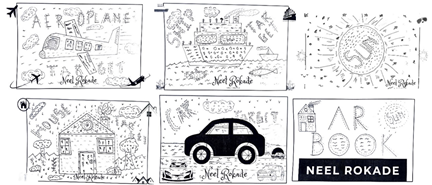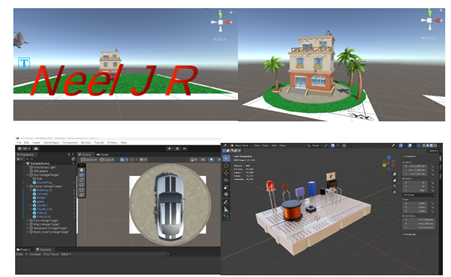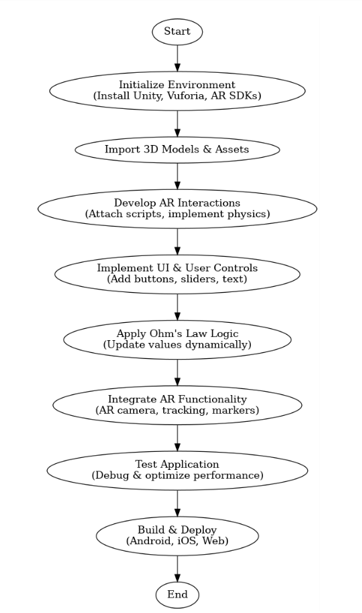
AUGMENTED REALITY IN EDUCATION: ENHANCING LEARNING THROUGH IMMERSIVE TECHNOLOGY
Neel Jeevan Rokade 1, Dr. Arti Wadhekar 1
1 Department
of Electronics and Telecommunication Engineering D.I.E.M.S., Chh. Sambhajinagar
|
|
ABSTRACT |
||
|
Augmented
Reality (AR) has emerged as a transformative technology in education,
offering immersive and interactive learning experiences. By integrating
digital elements with real-world environments, AR enhances student
engagement, comprehension, and retention. This paper explores the application
of AR in educational settings, examining its benefits, challenges, and future
implications. A review of existing literature, case studies, and real-world
implementations assesses the effectiveness of AR in various educational
contexts, demonstrating its potential to revolutionize modern learning.
Furthermore, this study investigates the implementation of an IoT-based load
on-off system using a NodeMCU (ESP8266) and a relay
module to control an AC light bulb. The NodeMCU
functions as a microcontroller, sending control signals to the relay module,
which serves as an electrically operated switch. This system is widely used
in IoT automation, allowing remote control of electrical appliances via
Wi-Fi, enhancing convenience, efficiency, and energy management. |
|||
|
Received 06 February
2025 Accepted 12 March 2025 Published 12 April 2025 DOI 10.29121/granthaalayah.v13.i3.2025.6034 Funding: This research
received no specific grant from any funding agency in the public, commercial,
or not-for-profit sectors. Copyright: © 2025 The
Author(s). This work is licensed under a Creative Commons
Attribution 4.0 International License. With the
license CC-BY, authors retain the copyright, allowing anyone to download,
reuse, re-print, modify, distribute, and/or copy their contribution. The work
must be properly attributed to its author.
|
|||
|
Keywords: NODE MCU ESP8266, Wi-Fi Module, Relay,
Argument Reality, Internet of Things |
|||
1. INTRODUCTION
The evolution of educational technology has led to significant advancements in teaching and learning methodologies. Augmented Reality (AR), a technology that overlays digital content onto the real world, has the potential to revolutionize education by making learning more engaging and interactive. This paper examines how AR enhances education, the challenges associated with its adoption, and future prospects. AR technology is based on the principle of blending digital and physical environments to create enriched learning experiences. Constructivist and experiential learning theories support AR's effectiveness in education, emphasizing active engagement, hands-on learning, and real-world application of knowledge.
Furthermore, this study investigates the implementation of an IoT-based home automation system using a NodeMCU (ESP8266) and a relay module to control an AC light bulb. The NodeMCU functions as a microcontroller, sending control signals to the relay module, which serves as an electrically operated switch. This setup allows the low-voltage NodeMCU (3.3V logic) to safely control a high-voltage 240V AC circuit. The light bulb is connected to the AC power supply, with one wire passing through the relay module. The relay features three terminals on the high-voltage side: Common (COM), Normally Open (NO), and Normally Closed (NC). When activated, the NodeMCU establishes a connection between COM and NO, enabling current flow and turning on the light. This system is widely used in IoT-based home automation, allowing remote control of electrical appliances via Wi-Fi, enhancing convenience, efficiency, and energy management.
Despite the rapid advancements in educational technology, traditional teaching methods still struggle to engage students effectively, leading to decreased retention and comprehension. Augmented Reality (AR) has the potential to address these challenges by creating immersive and interactive learning environments. However, the integration of AR in education faces several obstacles, including high implementation costs, technical constraints, lack of teacher training, and limited availability of quality AR content. This paper aims to analyze the impact of AR on student learning outcomes, explore the barriers to its adoption, and propose strategies for its effective implementation in various educational settings.
· To explore the role of Augmented Reality (AR) in enhancing student engagement, comprehension, and retention in educational settings.
· To assess the effectiveness of AR-based learning tools through a review of literature, case studies, and real-world applications.
· To identify the challenges and limitations associated with implementing AR in education, including cost, technical constraints, and educator readiness.
· To analyze potential solutions and strategies for overcoming barriers to AR adoption in educational institutions.
· To examine the future implications of AR in education, including advancements in AI, machine learning, and cloud computing.
· To provide recommendations for policymakers, educators, and technology developers to effectively integrate AR into modern learning environments.
2. RESEARCH BACKGROUND
Augmented Reality (AR) is a technology that superimposes digital information, such as images, text, and sounds, onto the real-world environment, which is typically viewed using devices such as smartphones, tablets, or AR glasses. AR improves the user's perception of the physical world by integrating digital elements with real-world environments in real time Azuma 1997. In educational settings, AR is commonly used to create interactive learning experiences that engage students more deeply with the material. AR applications, for example, can make textbooks more engaging by allowing students to interact with 3D models of scientific concepts, historical artifacts, and geographical landmarks Billinghurst & Duenser, 2012. This technology has been especially effective in subjects like science, math, and history, where complex ideas or abstract concepts can be visualized and explored more tangibly, thereby improving student comprehension and retention.
One well-known example of augmented reality in education is the use of mobile applications that allow students to scan images in textbooks, triggering animations or detailed 3D visualizations. This allows students to interact with content in a multisensory manner, catering to a variety of learning styles. AR can improve student motivation, engagement, and performance, especially in active learning settings. AR also promotes collaborative learning by allowing students to share the same augmented experiences and participate in group problem-solving activities, making learning more dynamic and interactive.
Virtual Reality (VR) is an immersive technology that creates fully digital environments, allowing users to experience and interact with simulated worlds via head-mounted displays (HMDs) or VR headsets. Unlike AR, which superimposes digital elements on the real world, VR immerses users in completely virtual environments, blocking out the physical world. This immersive quality makes VR an effective tool for experiential learning, allowing students to "step inside" simulations of places or events that would otherwise be difficult or impossible to access in the real world. In education, VR is used to create virtual field trips, historical re-enactments, or simulations in science, medicine, and engineering, allowing students to explore environments and practice skills in a controlled, safe environment.
The immersive nature of VR increases engagement by giving students a sense of presence and active participation in their learning environments. According to research, virtual reality can improve spatial awareness, problem-solving abilities, and group collaboration. For example, in medical education, VR enables students to practice surgical techniques or explore human anatomy in 3D without the risks associated with real-life practice. VR's ability to simulate complex, high-stakes scenarios makes it especially useful in training settings, where experiential learning is essential for skill development and knowledge retention.
3. PROPOSED SYSTEM
Figure1

|
Figure 1 Block Diagram |
This block diagram illustrates a Wi-Fi-based IoT system for controlling electrical loads using a NodeMCU (ESP8266) and a relay module. The MSEB supply represents the main AC power source, which is stepped down by a transformer to a lower voltage. This lower voltage is then processed by a power supply unit to provide the necessary DC voltage for the NodeMCU and other components. The NodeMCU (ESP8266) acts as the central controller, receiving commands from a mobile application via Wi-Fi. Based on the received input, the NodeMCU sends signals to the relay module, which acts as an electronic switch to control the load (such as a light or fan). This system enables remote operation of electrical devices, making it ideal for home automation applications
Technical Specification:
ESP8266: A low-cost Wi-Fi microcontroller used for IoT applications, offering built-in TCP/IP networking capabilities. It has 9 digital pins and 1 analog pin. It operates on 5V dc.
Figure 2

|
Figure 2 ESP8266 |
Relay Module: A switching device that allows the low-voltage ESP8266 (3.3V logic) to control high-voltage loads safely. Its operating voltage is 12V dc. It has three terminal VCC, GND and signal.
Figure 3

|
Figure 3 Relay module |
Load: Electrical appliances such as an AC light bulb (typically 240V) that can be remotely controlled using IoT-based automation.
Figure 4

|
Figure 4 Bulb |
4. RESULT & DISCUSSION
This circuit diagram demonstrates how to control an AC light bulb using a NodeMCU (ESP8266) and a relay module. The NodeMCU serves as the microcontroller, sending control signals to the relay module, which acts as an electrically operated switch. The relay allows the low-voltage NodeMCU (3.3V logic) to safely control the high-voltage 240V AC circuit. The light bulb is connected to the AC power supply, with one of its wires passing through the relay module. The relay has three terminals on the high-voltage side: Common (COM), Normally Open (NO), and Normally Closed (NC). When the NodeMCU activates the relay, the connection between COM and NO is established, allowing current to flow and turning on the light. This setup is commonly used in IoT-based home automation systems, enabling remote control of electrical appliances via Wi-Fi.
Figure 5

|
Figure 5 Circuit Diagram |
The mobile screen displays an AR button control panel, created using platforms like Vuforia and Unity, which allows users to turn the light on or off by interacting with virtual buttons. When a user taps the AR button, the command is sent via an IoT platform such as Blynk or MQTT to a NodeMCU (ESP8266) microcontroller, which is connected to a relay module. The relay then switches the light on or off accordingly. This technology combines Augmented Reality and IoT to provide an intuitive and futuristic way of managing home automation, enhancing convenience and user experience.
Figure 6

|
Figure 6 Final Project |
Unity 3D is a powerful cross-platform game engine widely used for creating interactive applications, including games, virtual reality (VR), and augmented reality (AR). It is highly versatile, allowing developers to build both 2D and 3D experiences across multiple platforms. Unity provides a user-friendly interface and a range of tools for creating realistic environments, animations, and interactivity. It is widely used in education, healthcare, architecture, and entertainment for creating immersive experiences.
Vuforia is an augmented reality (AR) platform that allows developers to build AR applications by enabling real-world object recognition and interaction. It integrates seamlessly with Unity 3D, making it a popular choice for creating marker-based and marker less AR experiences. Vuforia supports a wide range of platforms and provides tools for recognizing and overlaying virtual content on physical objects.
Figure 7

|
Figure 7 Input Images of Sample |
The provided images showcase an Augmented Reality (AR) application that enhances hand-drawn sketches by overlaying digital 3D content. The input images (Fig. 7) consist of black-and-white drawings, including objects like airplanes, cars, and books, which serve as markers for the AR system. When these images are viewed through a smartphone or tablet, the AR system recognizes them and maps corresponding 3D models onto the sketches, as seen in the output images (Fig. 8). This transformation adds textures, colors, and animations, creating an interactive experience. The system likely works by detecting key features of the drawings, tracking their position, and rendering digital objects in real time. Such an AR setup has various applications, including education, where textbooks can be brought to life with interactive visuals, children's storybooks that feature animated characters, and even design prototyping, allowing users to visualize sketches in 3D. By seamlessly blending digital and physical elements, this AR system enhances learning, creativity, and engagement, making it a valuable tool for multiple industries.
Figure 8

|
Figure 8 Output Images of Sample |
Fig. 8 (Output Images of Sample): These shows how the AR system enhances the input images by adding digital 3D objects or animations. The smartphone screen displays interactive and colorful 3D models on top of the originally drawn sketches.
When the AR system detects an input image (such as a hand-drawn sketch), it maps a corresponding 3D model onto it. This process involves:
1. Image Recognition & Tracking: The AR system identifies the drawing and determines its position and orientation in real space.
2. Model Alignment & Projection: A pre-defined 3D model (e.g., a car, airplane, or book) is retrieved from the database and overlaid onto the detected drawing, maintaining scale and perspective.
3. Rendering & Interaction: The model is rendered with textures, lighting, and animations to create a realistic effect. Users can interact with it by rotating, zooming, or even triggering animations through touch or gestures.
Figure 9

|
Figure 9 Some Screenshot of Software |
· Mesh: The structural framework made up of interconnected polygons (usually triangles or quads).
· Textures: Image maps applied to the mesh to give it a realistic appearance (e.g., a metallic texture for a car).
· Materials & Shading: Defines how light interacts with the surface, adding reflections, shadows, and transparency effects.
· Animation & Rigging: If the object needs movement (e.g., an animated propeller for an airplane), bones and keyframes are added to create dynamic motion.
The Augmented Reality (AR) system with 3D models is designed for educational purposes, making learning more interactive and engaging. By overlaying digital 3D content onto hand-drawn sketches, students can visualize complex concepts in subjects like science, history, and engineering. AR enhances understanding by allowing learners to explore and interact with 3D models, making abstract topics more tangible. It increases engagement, improves retention, and bridges the gap between theory and real-world applications. This technology is particularly useful for STEM education, providing an immersive and hands-on learning experience.
Flow Chart
Figure 10

|
Figure 10 Flowchart |
Algorithm
· Initialize Unity 3D and install Vuforia SDK.
· Import & Position 3D models (e.g., circuits) in Unity.
· Develop Interactivity using C# scripts, UI sliders, and animations.
· Configure Vuforia for AR tracking (add image targets/models).
· Test & Optimize performance, tracking, and user experience.
· Deploy as APK/IPA for mobile/AR devices.
· Enhance with AI, multi-user support, and expanded content.
5. CONCLUSION
Augmented Reality (AR) has proven to be a powerful tool in modern education, enhancing engagement, comprehension, and interactivity. By integrating digital content with real-world environments, AR makes learning more immersive, particularly in subjects that require visualization of complex concepts. The combination of AR with Unity 3D and Vuforia enables the creation of interactive educational experiences, improving student motivation and retention. Despite challenges such as technical constraints, cost, and educator readiness, AR’s potential in education is immense. Future advancements in AI, cloud computing, and mixed reality will further enhance AR’s role in classrooms, making education more personalized and accessible. To maximize its impact, educators, policymakers, and developers must collaborate to integrate AR effectively into learning environments. The Augmented Reality (AR) system with 3D models is designed for educational purposes, making learning more interactive and engaging. By overlaying digital 3D content onto hand-drawn sketches, students can visualize complex concepts in subjects like science, history, and engineering. AR enhances understanding by allowing learners to explore and interact with 3D models, making abstract topics more tangible. It increases engagement, improves retention, and bridges the gap between theory and real-world applications. This technology is particularly useful for STEM education, providing an immersive and hands-on learning experience.
6. Applications
· STEM Education – AR visualizes scientific concepts (e.g., human anatomy, physics experiments).
· History & Geography – AR brings historical events and landmarks to life.
· Medical Training – Enables virtual surgery practice and anatomy exploration.
· Engineering & Architecture – Helps students design and interact with 3D models.
· Language Learning – AR-based translations and interactive storytelling enhance learning.
· Vocational Training – AR simulates real-world job environments for hands-on training.
· Special Education – AR assists students with disabilities through interactive learning aids.
· Education: Visualizing scientific models, anatomy, or historical artifacts interactively.
· Gaming & Entertainment: AR games overlay 3D characters and objects in real-world environments.
· Marketing & E-commerce: Brands use AR to showcase 3D product previews (e.g., trying on virtual shoes or placing furniture in a room).
· Architecture & Design: Helps in visualizing 3D building models from blueprints or sketches.
CONFLICT OF INTERESTS
None.
ACKNOWLEDGMENTS
None.
REFERENCES
Al-Ansi, A. M., Jaboob, M., Garad, A., & Al-Ansi, A. (2023). Analyzing augmented reality (AR) and virtual reality (VR) recent development in education. Social Sciences & Humanities Open, 8(1), 100532. https://doi.org/10.1016/j.ssaho.2023.100532
Faust, F., Roepke, G., Catecati, T., Araujo, F., Ferreira, M. G., & Albertazzi, D. (2012). Use of augmented reality in the usability evaluation of products. Work, 41(Suppl 1), 1164-1167. https://doi.org/10.3233/WOR-2012-0298-1164
Hynes, E., Flynn, R., Lee, B., & Murray, N. (2019). A quality of experience evaluation comparing augmented reality and paper-based instruction for complex task assistance. *2019 IEEE 21st International Workshop on Multimedia Signal Processing (MMSP)*, Kuala Lumpur, Malaysia, 1-6. https://doi.org/10.1109/MMSP.2019.8901705
Irshad, S., & Rohaya Bt Awang Rambli, D. (2014). User experience of mobile augmented reality: A review of studies. *2014 3rd International Conference on User Science and Engineering (i-USEr)*, Shah Alam, Malaysia, 125-130. https://doi.org/10.1109/IUSER.2014.7002689
Mendoza-Ramírez, C. E., Tudon-Martinez, J. C., Félix-Herrán, L. C., Lozoya-Santos, J. d. J., & Vargas-Martínez, A. (2023). Augmented reality: Survey. *Applied Sciences, 13*(10491). https://doi.org/10.3390/app131810491
Papageorgiou, G., & You, S. (2023). Augmented reality (AR): A new technology for advertising and marketing digital communications. *2023 Zooming Innovation in Consumer Technologies Conference (ZINC)*, Novi Sad, Serbia, 56-61. https://doi.org/10.1109/ZINC58345.2023.10174141
Rehman, U., & Cao, S. (2015). Augmented reality-based indoor navigation using Google Glass as a wearable head-mounted display. *2015 IEEE International Conference on Systems, Man, and Cybernetics*, Hong Kong, China, 1452-1457. https://doi.org/10.1109/SMC.2015.257
Toth, D. M.-M., & Sîrghi, N. (2023). Consumers’ experience and satisfaction using AR apps in e-shopping. *MDPI*.
Voicu, M.-C., Sîrghi, N., & Toth, D. M.-M. (2023). Consumers’ experience and satisfaction using augmented reality apps in e-shopping: New empirical evidence. *Applied Sciences, 13*(9596). https://doi.org/10.3390/app13179596
 This work is licensed under a: Creative Commons Attribution 4.0 International License
This work is licensed under a: Creative Commons Attribution 4.0 International License
© Granthaalayah 2014-2025. All Rights Reserved.